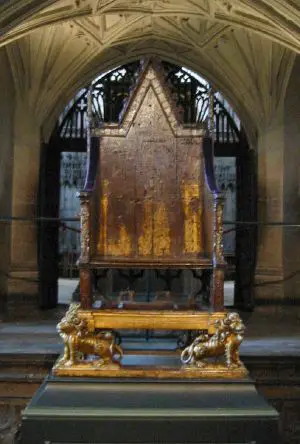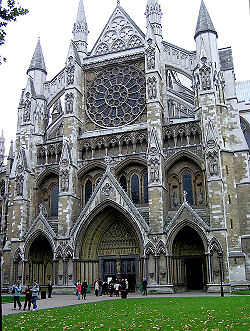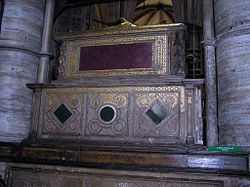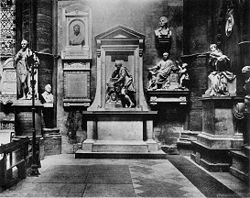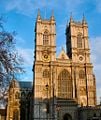Difference between revisions of "Westminster Abbey" - New World Encyclopedia
Rosie Tanabe (talk | contribs) |
|||
| (28 intermediate revisions by 10 users not shown) | |||
| Line 1: | Line 1: | ||
| − | {{ | + | {{Images OK}}{{submitted}}{{approved}}{{Paid}}{{Copyedited}} |
{{Infobox World Heritage Site | {{Infobox World Heritage Site | ||
| Line 13: | Line 13: | ||
| Link = http://whc.unesco.org/en/list/426 | | Link = http://whc.unesco.org/en/list/426 | ||
}} | }} | ||
| − | '''The Collegiate Church of St Peter, Westminster''', | + | '''The Collegiate Church of St. Peter, Westminster''', normally called '''Westminster Abbey''', is a large, mainly [[Gothic architecture|Gothic]] [[Church (building)|church]] in [[Westminster]], [[London]], just to the west of the [[Palace of Westminster]]. Neither a [[cathedral]] nor a [[parish]] church, Westminster Abbey is a church owned directly by the British [[royal family]]. |
| − | + | Since the [[Christmas]] Day coronation of [[William the Conqueror]] in 1066, nearly all English [[monarchy|monarch]]s have been crowned in the abbey. [[St. Edward]]'s Chair, the [[throne]] on which British sovereigns are seated at the moment of coronation, is housed within the abbey. | |
| − | + | Due its connections to royalty, it was spared [[King Henry VIII]]'s attack on monastic buildings during the Reformation. Many British kings and queens are buried within Westminster, along with other notable figures. For example, the tombs of both the [[Protestant]] [[Elizabeth I]] and [[Catholic]] [["Bloody" Mary]], along with the tombs of [[Geoffrey Chaucer]], [[David Livingstone]] and [[Charles Darwin]], are found within the abbey. | |
| + | {{toc}} | ||
| + | Located next to the [[Houses of Parliament]] in the Westminster neighborhood of [[London]], Westminster Abbey is a popular London [[tourist]] destination. With its oldest parts dating to the year 1050, the Abbey contains some of the most glorious medieval [[architecture]] in London. | ||
==History== | ==History== | ||
| − | + | [[Image:SanktEdvardsstol westminster.jpg|thumb|King Edward's Chair]] | |
| − | [[ | + | [[Image:Westminster Abbey C20th martyrs.jpg|thumb|right|250px|Christian [[martyr]]s from across the world statues above the Great West Door]] |
| − | + | [[Tradition]] claims that a [[shrine]] was first built where the Abbey is now located in 616 on a site then known as [[Thorney Island]], which became a place of pilgrimage after a fisherman on the [[River Thames]] saw a [[vision]] of [[Saint Peter]] there. The early shrine's existence, however, is not certain. The historic [[abbey]] was first built by [[Edward the Confessor]] between 1045-1050 and consecrated on December 28, 1065. Ironically, its construction resulted from the pious Edward's breaking a vow to go on a [[pilgrimage]]; the [[Pope]] suggested that he redeem himself by building an abbey. | |
| − | |||
| − | |||
| − | |||
| − | |||
| − | |||
| − | + | The original abbey, in the [[Romanesque]] style that is called "[[Norman]]" in England, was built to house [[Benedictine]] [[monk]]s. It was rebuilt in the English [[Gothic]] style with Benedictine planning in stages between 1245-1517. The initial phase of the rebuilding was organized by [[Henry III]] as a shrine to honor [[Edward the Confessor]] and as a suitably regal setting for Henry's own tomb, under what would be the highest Gothic [[nave]] in England. | |
| − | |||
| − | + | Since the coronations in 1066 of both [[Harold Godwinson|King Harold]] and [[William the Conqueror]], nearly all English and British monarchs have been crowned in the abbey.<ref>The exceptions are [[Jane of England|Lady Jane Grey]], [[Edward V of England|Edward V]] and [[Edward VIII of the United Kingdom|Edward VIII]], who did not have coronations, and [[Henry III of England|Henry III]] because [[Louis VIII of France|Prince Louis]] of [[France]] had taken control of London.</ref> [[King Edward's Chair|St. Edward's Chair]], the throne on which [[United Kingdom|British]] sovereigns are seated at the moment of coronation, is housed within the west front of the abbey.<ref> The [[throne]] was largely finished by the architect [[Henry Yevele]] in the reign of King [[Richard II]].</ref> | |
| − | |||
| − | + | [[Westminster School]] and [[Westminster Abbey Choir School]] are also in the precincts of the Abbey. [[Benedictine]] monks were required by the Pope to maintain a charity school in 1179. Westminster School may have been founded even earlier for children or novices, and the legendary [[Croyland Chronicle]] relates a story of [[Edward the Confessor]]'s Queen [[Edith of Wessex|Editha]] chatting to a schoolboy in the cloisters, and sending him off to the Palace larder for a treat. | |
| − | + | [[Henry VII]] added a perpendicular style chapel dedicated to the [[Virgin Mary]] in 1503 (known as the Henry VII Lady Chapel). The [[Archbishop of Canterbury]] is the traditional [[clergy|cleric]] in the [[Coronation of the British monarch|coronation]] ceremony. | |
| − | |||
| − | The abbey | + | Unlike most other English abbeys, the abbey was saved from destruction due to its royal connections, when it was claimed by [[Henry VIII]] during the [[Dissolution of the Monasteries]] in 1534. The expression "robbing Peter to pay Paul" may have come from this period when funds intended for the abbey, which was dedicated to [[St. Peter]], were diverted to the treasury of [[St. Paul's Cathedral]]. |
| − | + | [[Queen Mary]] restored the abbey to the [[Benedictine]]s, but they were again ejected under [[Queen Elizabeth I]] in 1559. In 1579, [[Elizabeth]] re-established Westminster as a "royal peculiar"—a church responsible directly to the [[sovereign]], rather than to a diocesan bishop—and made it the [[Collegiate Church of St. Peter]] (i.e. a church with an attached chapter of [[canon]]s, headed by a dean). | |
| − | [[ | ||
| − | |||
| − | + | During the turbulent 1640s, the abbey suffered damage when it was attacked by [[Puritan]] iconoclasts, but was again protected by its close ties to the state during the Commonwealth period. [[Oliver Cromwell]] was given an elaborate [[funeral]] there in 1658, only to be disinterred in January 1661 after the restoration of the monarchy and posthumously hanged and quartered. His empty tomb, however, is still visible inside. | |
| − | + | Under the guidance of [[architect]]s [[Sir Christopher Wren]] and [[Nicholas Hawksmoor], the abbey's two western towers were built between 1722 and 1745, constructed from Portland [[stone]] to an early example of a [[Gothic Revival]] design. Further rebuilding and restoration occurred in the nineteenth century under [[Sir George Gilbert Scott]]. | |
| − | |||
| − | + | Until the nineteenth century, Westminster was the third seat of learning in England, after [[Oxford University|Oxford]] and [[Cambridge University|Cambridge]] universities. It was here that the first third of the ''[[King James Bible Old Testament]]'' and the last half of the ''[[New Testament]]'' were translated. In the twentieth century, the ''[[New English Bible]]'' was compiled at the abbey. | |
| − | === | + | ==Coronations== |
| − | [[Image:Westminster abbey | + | {{readout||left|250px|Since 1066, the coronations of English and British [[monarch]]s have been held in Westminster Abbey}} |
| − | [[Henry III of England|Henry III]] | + | [[Image:Westminster.abbey.northentrance.arp.500pix.jpg|thumb|right|250px| The North entrance of Westminster Abbey]] |
| + | As indicated above, since the coronations in 1066 of both [[Harold Godwinson|King Harold]] and [[William the Conqueror]], coronations of English and British monarchs were held in the Abbey.<ref>[http://www.westminster-abbey.org/our-history History] Dean and Chapter of Westminster Abbey. Retrieved June 28, 2013.</ref><ref>[http://www.westminster-abbey.org/our-history/royals/coronations Coronations] Dean and Chapter of Westminster Abbey. Retrieved June 28, 2013.</ref> [[Henry III of England|Henry III]] was unable to be crowned in London when he first came to the throne because the French prince [[Louis VIII of France|Louis]] had taken control of the city, and so the king was crowned in [[Gloucester Cathedral]]. However, this coronation was deemed by the Pope to be improper, and a further coronation was held in the Abbey on May 17, 1220.<ref>[http://www.archontology.org/nations/england/king_england/henry3.php Henry III]. Archonotology.org. Retrieved June 28, 2013.</ref> The [[Archbishop of Canterbury]] is the traditional [[clergy|cleric]] in the coronation ceremony. | ||
| − | + | [[King Edward's Chair]] (or St Edward's Chair), the throne on which English and British sovereigns have been seated at the moment of coronation, is housed within the Abbey and has been used at every coronation since 1308. From 1301 to 1996 (except for a short time in 1950 when it was temporarily stolen by [[Scottish nationalist]]s), the chair also housed the [[Stone of Scone]] upon which the kings of Scots are crowned. Although the Stone is now kept in Scotland, in [[Edinburgh Castle]], at future coronations it is intended that the Stone will be returned to St Edward's Chair for use during the coronation ceremony. | |
| − | + | ==Royal weddings== | |
| + | The Abbey has been the location of many royal weddings: | ||
| + | # '''November 11, 1100''': [[King Henry I of England]] was married to [[Matilda of Scotland]] | ||
| + | # '''January 4, 1243''': [[Richard, Earl of Cornwall]] (later King of Germany), brother of King [[Henry III of England]], to [[Sanchia of Provence]] (his second wife). Sanchia was sister of [[Eleanor of Provence]], Henry III’s queen. | ||
| + | # '''April 9, 1269''': [[Edmund Crouchback|Edmund of Crouchback, 1st Earl of Leicester and Lancaster]], son of King Henry III was married to Lady [[Aveline de Forz]] | ||
| + | # '''April 30, 1290''': [[Joan of Acre]], daughter of [[Edward I of England|King Edward I]] was married to the 7th Earl of Gloucester | ||
| + | # '''July 8, 1290''': [[Margaret of England, Duchess of Brabant|Margaret of England]], daughter of King Edward I was married to John II, son of Duke of Brabant | ||
| + | # '''January 20, 1382''': [[Richard II of England|King Richard II of England]] was married to [[Anne of Bohemia]] | ||
| + | # '''February 27, 1919''': [[Princess Patricia of Connaught]] was married to Capt the Hon [[Alexander Ramsay (Royal Navy officer)|Alexander Ramsay]] | ||
| + | # '''February 28, 1922''': [[Mary, Princess Royal and Countess of Harewood|The Princess Mary]], daughter of King George V was married to [[Henry Lascelles, 6th Earl of Harewood|Viscount Lascelles]] | ||
| + | # '''April 26, 1923''': [[George VI|The Prince Albert, Duke of York]] (later King George VI), second son of King George V was married to Lady Elizabeth Bowes-Lyon (later to become [[Queen Elizabeth The Queen Mother]]) | ||
| + | # '''November 29, 1934''': [[Prince George, Duke of Kent|The Prince George, Duke of Kent]], son of King George V was married to [[Princess Marina of Greece and Denmark]] | ||
| + | # '''November 20, 1947''': Princess Elizabeth (now Queen [[Elizabeth II]]), elder daughter of King George VI [[Wedding of Princess Elizabeth and Philip Mountbatten, Duke of Edinburgh|was married]] to the [[Prince Philip, Duke of Edinburgh|Duke of Edinburgh]] (who was Lt Philip Mountbatten until that morning) | ||
| + | # '''May 6, 1960''': [[Princess Margaret, Countess of Snowdon|Princess Margaret]], second daughter of King George VI was married to [[Antony Armstrong-Jones, 1st Earl of Snowdon|Antony Armstrong-Jones]] (later [[Earl of Snowdon]]) | ||
| + | # '''April 24, 1963''': [[Princess Alexandra, The Honourable Lady Ogilvy|Princess Alexandra of Kent]] was married to the Hon [[Angus Ogilvy]] | ||
| + | # '''November 14, 1973''': [[Anne, Princess Royal|Princess Anne]], only daughter of [[Elizabeth II]] was married to Captain [[Mark Phillips]] | ||
| + | # '''July 23, 1986''': [[Prince Andrew, Duke of York]], second son of [[Elizabeth II]], was married to Miss [[Sarah, Duchess of York|Sarah Ferguson]] | ||
| + | # '''April 29, 2011''': [[Prince William, Duke of Cambridge]], grandson of [[Elizabeth II]], [[Wedding of Prince William and Catherine Middleton|was married]] to Miss [[Catherine, Duchess of Cambridge|Catherine Middleton]] | ||
| + | ==Burials and Memorials== | ||
| + | [[Image:westminster.abbey.tombofhenry.london.arp.jpg|thumb|250px| The tomb of King Henry III]] | ||
| + | [[Image:Poets corner.jpg|thumb|250px|Poets Corner]] | ||
| + | Westminster is the site of some of England's most notable tombs. [[Edward the Confessor]]'s relics were placed in a [[shrine]] in the sanctuary after [[Henry III]] rebuilt the abbey in the thirteenth century. Henry III himself was interred nearby in a superb [[tomb|chest tomb]] with [[church monument|effigial monument]], as were many of the [[Plantagenet]] kings of England, their wives, and other relatives. Subsequently, most Kings and Queens of England were buried here, although [[Henry VIII of England|Henry VIII]] and [[Charles I of England|Charles I]] are buried at [[St. George's Chapel, Windsor|St. George's Chapel]] in [[Windsor Castle]], as are all [[monarchy|monarch]]s and royals after [[George II of Great Britain|George II]]. | ||
| + | In 2005, the original ancient [[burial vault (tomb)|burial vault]] of [[Edward the Confessor]] was discovered, beneath the 1268 [[Cosmati]] mosaic pavement, in front of the high altar. A series of royal vaults dating back to the thirteenth and fourteenth centuries was also discovered using [[ground-penetrating radar]]. | ||
| − | + | [[Aristocrat]]s were buried inside chapels and monks and people associated with the [[abbey]] were buried in the cloisters and other areas. One of these was [[Geoffrey Chaucer]], who had apartments in the abbey, where he was employed as master of the Kings Works. Other [[poet]]s were later buried around Chaucer in what became known as [[Poets' Corner]], as well as memorials to [[William Shakespeare]], [[Charles Dickens]], and other giants of [[literature]]. | |
| − | [[ | + | Abbey musicians such as [[Henry Purcell]] were also buried in their place of work. Subsequently, it became an honor to be buried or memorialized here. The practice spread from aristocrats and poets to [general]]s, [[admiral]]s, [[politician]]s, [[scientist]]s, [[doctor]]s, etc. |
== Organ == | == Organ == | ||
| + | The abbey organ was built by [[Harrison & Harrison]] in 1937, with four manuals and 84 speaking stops, and was used for the first time at the Coronation of [[King George VI]]. Some pipework from the previous five-manual Hill organ was revoiced and incorporated in the new scheme. The two organ cases, designed in the late-nineteenth century by [[John Loughborough Pearson]], were re-instated and colored in 1959.<ref>[http://npor.emma.cam.ac.uk/cgi-bin/Rsearch.cgi?Fn=Rsearch&rec_index=N00646 National Pipe Organ Register.], The British Institute of Organ Studies, 2005. Retrieved January 28, 2008.</ref> | ||
| − | The | + | ==Abbey organization== |
| − | + | [[Image:Westminster abbey night.jpg|thumb|300px|right|The Abbey at night, from Dean's Yard. Artificial light reveals the [[exoskeleton]] formed by [[flying buttress]]es]] | |
| − | + | The abbey is a [[collegiate church]] organized into the College of St. Peter, which comprises the Dean and four resident Canons (one of whom is also [[Rector]] of [[St. Margaret's, Westminster|St Margaret's Church, Westminster]], and Speaker's Chaplain), and 17 other persons who are members ex officio, as well as 12 [[lay vicars]] and ten choristers. | |
| − | |||
| − | |||
| − | |||
| − | + | The 17 are the [[Receiver-General]] and [[Chapter Clerk]], the [[Registrar]], the [[Auditor]], the Legal Secretary, and the [[Clerk of the Works]] (the administrative officers). Those more directly concerned with liturgical and ceremonial operations include the [[Precentor]], the Chaplain and [[Sacrist]], the Organist, and the (honorary) [[High Steward of Westminster Abbey|High Steward]] and [[High Bailiff of Westminster Abbey|High Bailiff]]. Lastly, the educational role of the abbey is reflected in the presence of the Headmaster of the Choir School, the Headmaster and Under Master of [[Westminster School]], and the Master of The [[Queen's Scholar]]s. The abbey is governed by the Dean and Chapter established under the Elizabethan statute of 1560. | |
| − | |||
| − | |||
| − | The | ||
| − | |||
| − | The | ||
== Gallery == | == Gallery == | ||
| − | |||
<gallery> | <gallery> | ||
Image:Westminster Abbey London 900px.jpg|Westminster Abbey, as seen from the west | Image:Westminster Abbey London 900px.jpg|Westminster Abbey, as seen from the west | ||
Image:Westminster Abbey West Door.jpg|Westminster Abbey's West Door in sunshine | Image:Westminster Abbey West Door.jpg|Westminster Abbey's West Door in sunshine | ||
Image:Westminster.abbey.westfront.london.arp.jpg|The west front | Image:Westminster.abbey.westfront.london.arp.jpg|The west front | ||
| − | |||
Image:Westminsterabbeyfromeye.jpg|Rear side view from the nearby [[London Eye]] | Image:Westminsterabbeyfromeye.jpg|Rear side view from the nearby [[London Eye]] | ||
| − | |||
</gallery> | </gallery> | ||
| − | + | ==Notes== | |
| − | + | <references/> | |
| − | |||
== References == | == References == | ||
| − | *Bradley, Simon, | + | *Bradley, Simon, and Nikolaus Pevsner. ''The Buildings of England-London 6: Westminster''. Yale University Press, 2003. ISBN 0300095953 |
| − | *Harvey, Barbara. ''Living and Dying in England 1100-1540: The Monastic Experience'' | + | *Harvey, Barbara. ''Living and Dying in England 1100-1540: The Monastic Experience''. Clarendon Press, 1995. ISBN 9780198204312 |
| − | + | *Hexham, Irving. ''The Christian Traveler's Guide to Great Britain''. Zondervan Publishing Company, 2001. ISBN 9780310225522 | |
| − | *Hexham, Irving. ''The Christian Traveler's Guide to Great Britain'' | + | *Knighton, C.S., and Richard Mortimer. ''Westminster Abbey Reformed: 1540-1640''. Ashgate Publishing, 2003. ISBN 9780754608608 |
| − | |||
| − | |||
| − | |||
| − | |||
| − | * | ||
| − | |||
== External links == | == External links == | ||
| − | *[http://www.westminster-abbey.org/ Westminster Abbey] | + | All links retrieved May 4, 2023. |
| − | + | *[http://www.westminster-abbey.org/ Westminster Abbey] – ''www.westminster-abbey.org''. | |
| − | |||
| + | {{World Heritage Sites in the United Kingdom}} | ||
| + | {{Credit|140316521}} | ||
| − | + | [[Category:Geography]] | |
| − | [[Category: | + | [[Category:World Heritage Sites in the United Kingdom]] |
| − | |||
Latest revision as of 17:21, 4 May 2023
| Westminster Palace, Westminster Abbey and Saint Margaret's Church* | |
|---|---|
| UNESCO World Heritage Site | |
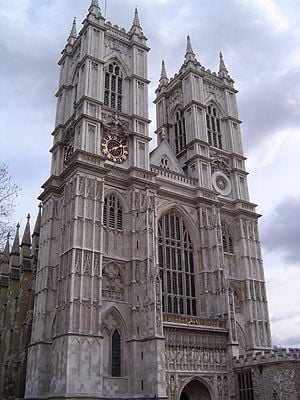
| |
| State Party | |
| Type | Cultural |
| Criteria | i, ii, iv |
| Reference | 426 |
| Region** | Europe and North America |
| Inscription history | |
| Inscription | 1987 (11th Session) |
| * Name as inscribed on World Heritage List. ** Region as classified by UNESCO. | |
The Collegiate Church of St. Peter, Westminster, normally called Westminster Abbey, is a large, mainly Gothic church in Westminster, London, just to the west of the Palace of Westminster. Neither a cathedral nor a parish church, Westminster Abbey is a church owned directly by the British royal family.
Since the Christmas Day coronation of William the Conqueror in 1066, nearly all English monarchs have been crowned in the abbey. St. Edward's Chair, the throne on which British sovereigns are seated at the moment of coronation, is housed within the abbey.
Due its connections to royalty, it was spared King Henry VIII's attack on monastic buildings during the Reformation. Many British kings and queens are buried within Westminster, along with other notable figures. For example, the tombs of both the Protestant Elizabeth I and Catholic "Bloody" Mary, along with the tombs of Geoffrey Chaucer, David Livingstone and Charles Darwin, are found within the abbey.
Located next to the Houses of Parliament in the Westminster neighborhood of London, Westminster Abbey is a popular London tourist destination. With its oldest parts dating to the year 1050, the Abbey contains some of the most glorious medieval architecture in London.
History
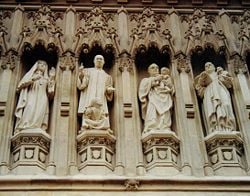
Tradition claims that a shrine was first built where the Abbey is now located in 616 on a site then known as Thorney Island, which became a place of pilgrimage after a fisherman on the River Thames saw a vision of Saint Peter there. The early shrine's existence, however, is not certain. The historic abbey was first built by Edward the Confessor between 1045-1050 and consecrated on December 28, 1065. Ironically, its construction resulted from the pious Edward's breaking a vow to go on a pilgrimage; the Pope suggested that he redeem himself by building an abbey.
The original abbey, in the Romanesque style that is called "Norman" in England, was built to house Benedictine monks. It was rebuilt in the English Gothic style with Benedictine planning in stages between 1245-1517. The initial phase of the rebuilding was organized by Henry III as a shrine to honor Edward the Confessor and as a suitably regal setting for Henry's own tomb, under what would be the highest Gothic nave in England.
Since the coronations in 1066 of both King Harold and William the Conqueror, nearly all English and British monarchs have been crowned in the abbey.[1] St. Edward's Chair, the throne on which British sovereigns are seated at the moment of coronation, is housed within the west front of the abbey.[2]
Westminster School and Westminster Abbey Choir School are also in the precincts of the Abbey. Benedictine monks were required by the Pope to maintain a charity school in 1179. Westminster School may have been founded even earlier for children or novices, and the legendary Croyland Chronicle relates a story of Edward the Confessor's Queen Editha chatting to a schoolboy in the cloisters, and sending him off to the Palace larder for a treat.
Henry VII added a perpendicular style chapel dedicated to the Virgin Mary in 1503 (known as the Henry VII Lady Chapel). The Archbishop of Canterbury is the traditional cleric in the coronation ceremony.
Unlike most other English abbeys, the abbey was saved from destruction due to its royal connections, when it was claimed by Henry VIII during the Dissolution of the Monasteries in 1534. The expression "robbing Peter to pay Paul" may have come from this period when funds intended for the abbey, which was dedicated to St. Peter, were diverted to the treasury of St. Paul's Cathedral.
Queen Mary restored the abbey to the Benedictines, but they were again ejected under Queen Elizabeth I in 1559. In 1579, Elizabeth re-established Westminster as a "royal peculiar"—a church responsible directly to the sovereign, rather than to a diocesan bishop—and made it the Collegiate Church of St. Peter (i.e. a church with an attached chapter of canons, headed by a dean).
During the turbulent 1640s, the abbey suffered damage when it was attacked by Puritan iconoclasts, but was again protected by its close ties to the state during the Commonwealth period. Oliver Cromwell was given an elaborate funeral there in 1658, only to be disinterred in January 1661 after the restoration of the monarchy and posthumously hanged and quartered. His empty tomb, however, is still visible inside.
Under the guidance of architects Sir Christopher Wren and [[Nicholas Hawksmoor], the abbey's two western towers were built between 1722 and 1745, constructed from Portland stone to an early example of a Gothic Revival design. Further rebuilding and restoration occurred in the nineteenth century under Sir George Gilbert Scott.
Until the nineteenth century, Westminster was the third seat of learning in England, after Oxford and Cambridge universities. It was here that the first third of the King James Bible Old Testament and the last half of the New Testament were translated. In the twentieth century, the New English Bible was compiled at the abbey.
Coronations
As indicated above, since the coronations in 1066 of both King Harold and William the Conqueror, coronations of English and British monarchs were held in the Abbey.[3][4] Henry III was unable to be crowned in London when he first came to the throne because the French prince Louis had taken control of the city, and so the king was crowned in Gloucester Cathedral. However, this coronation was deemed by the Pope to be improper, and a further coronation was held in the Abbey on May 17, 1220.[5] The Archbishop of Canterbury is the traditional cleric in the coronation ceremony.
King Edward's Chair (or St Edward's Chair), the throne on which English and British sovereigns have been seated at the moment of coronation, is housed within the Abbey and has been used at every coronation since 1308. From 1301 to 1996 (except for a short time in 1950 when it was temporarily stolen by Scottish nationalists), the chair also housed the Stone of Scone upon which the kings of Scots are crowned. Although the Stone is now kept in Scotland, in Edinburgh Castle, at future coronations it is intended that the Stone will be returned to St Edward's Chair for use during the coronation ceremony.
Royal weddings
The Abbey has been the location of many royal weddings:
- November 11, 1100: King Henry I of England was married to Matilda of Scotland
- January 4, 1243: Richard, Earl of Cornwall (later King of Germany), brother of King Henry III of England, to Sanchia of Provence (his second wife). Sanchia was sister of Eleanor of Provence, Henry III’s queen.
- April 9, 1269: Edmund of Crouchback, 1st Earl of Leicester and Lancaster, son of King Henry III was married to Lady Aveline de Forz
- April 30, 1290: Joan of Acre, daughter of King Edward I was married to the 7th Earl of Gloucester
- July 8, 1290: Margaret of England, daughter of King Edward I was married to John II, son of Duke of Brabant
- January 20, 1382: King Richard II of England was married to Anne of Bohemia
- February 27, 1919: Princess Patricia of Connaught was married to Capt the Hon Alexander Ramsay
- February 28, 1922: The Princess Mary, daughter of King George V was married to Viscount Lascelles
- April 26, 1923: The Prince Albert, Duke of York (later King George VI), second son of King George V was married to Lady Elizabeth Bowes-Lyon (later to become Queen Elizabeth The Queen Mother)
- November 29, 1934: The Prince George, Duke of Kent, son of King George V was married to Princess Marina of Greece and Denmark
- November 20, 1947: Princess Elizabeth (now Queen Elizabeth II), elder daughter of King George VI was married to the Duke of Edinburgh (who was Lt Philip Mountbatten until that morning)
- May 6, 1960: Princess Margaret, second daughter of King George VI was married to Antony Armstrong-Jones (later Earl of Snowdon)
- April 24, 1963: Princess Alexandra of Kent was married to the Hon Angus Ogilvy
- November 14, 1973: Princess Anne, only daughter of Elizabeth II was married to Captain Mark Phillips
- July 23, 1986: Prince Andrew, Duke of York, second son of Elizabeth II, was married to Miss Sarah Ferguson
- April 29, 2011: Prince William, Duke of Cambridge, grandson of Elizabeth II, was married to Miss Catherine Middleton
Burials and Memorials
Westminster is the site of some of England's most notable tombs. Edward the Confessor's relics were placed in a shrine in the sanctuary after Henry III rebuilt the abbey in the thirteenth century. Henry III himself was interred nearby in a superb chest tomb with effigial monument, as were many of the Plantagenet kings of England, their wives, and other relatives. Subsequently, most Kings and Queens of England were buried here, although Henry VIII and Charles I are buried at St. George's Chapel in Windsor Castle, as are all monarchs and royals after George II.
In 2005, the original ancient burial vault of Edward the Confessor was discovered, beneath the 1268 Cosmati mosaic pavement, in front of the high altar. A series of royal vaults dating back to the thirteenth and fourteenth centuries was also discovered using ground-penetrating radar.
Aristocrats were buried inside chapels and monks and people associated with the abbey were buried in the cloisters and other areas. One of these was Geoffrey Chaucer, who had apartments in the abbey, where he was employed as master of the Kings Works. Other poets were later buried around Chaucer in what became known as Poets' Corner, as well as memorials to William Shakespeare, Charles Dickens, and other giants of literature.
Abbey musicians such as Henry Purcell were also buried in their place of work. Subsequently, it became an honor to be buried or memorialized here. The practice spread from aristocrats and poets to [general]]s, admirals, politicians, scientists, doctors, etc.
Organ
The abbey organ was built by Harrison & Harrison in 1937, with four manuals and 84 speaking stops, and was used for the first time at the Coronation of King George VI. Some pipework from the previous five-manual Hill organ was revoiced and incorporated in the new scheme. The two organ cases, designed in the late-nineteenth century by John Loughborough Pearson, were re-instated and colored in 1959.[6]
Abbey organization
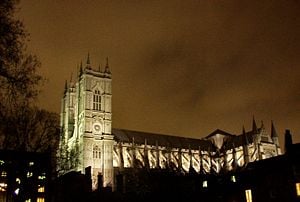
The abbey is a collegiate church organized into the College of St. Peter, which comprises the Dean and four resident Canons (one of whom is also Rector of St Margaret's Church, Westminster, and Speaker's Chaplain), and 17 other persons who are members ex officio, as well as 12 lay vicars and ten choristers.
The 17 are the Receiver-General and Chapter Clerk, the Registrar, the Auditor, the Legal Secretary, and the Clerk of the Works (the administrative officers). Those more directly concerned with liturgical and ceremonial operations include the Precentor, the Chaplain and Sacrist, the Organist, and the (honorary) High Steward and High Bailiff. Lastly, the educational role of the abbey is reflected in the presence of the Headmaster of the Choir School, the Headmaster and Under Master of Westminster School, and the Master of The Queen's Scholars. The abbey is governed by the Dean and Chapter established under the Elizabethan statute of 1560.
Gallery
Notes
- ↑ The exceptions are Lady Jane Grey, Edward V and Edward VIII, who did not have coronations, and Henry III because Prince Louis of France had taken control of London.
- ↑ The throne was largely finished by the architect Henry Yevele in the reign of King Richard II.
- ↑ History Dean and Chapter of Westminster Abbey. Retrieved June 28, 2013.
- ↑ Coronations Dean and Chapter of Westminster Abbey. Retrieved June 28, 2013.
- ↑ Henry III. Archonotology.org. Retrieved June 28, 2013.
- ↑ National Pipe Organ Register., The British Institute of Organ Studies, 2005. Retrieved January 28, 2008.
ReferencesISBN links support NWE through referral fees
- Bradley, Simon, and Nikolaus Pevsner. The Buildings of England-London 6: Westminster. Yale University Press, 2003. ISBN 0300095953
- Harvey, Barbara. Living and Dying in England 1100-1540: The Monastic Experience. Clarendon Press, 1995. ISBN 9780198204312
- Hexham, Irving. The Christian Traveler's Guide to Great Britain. Zondervan Publishing Company, 2001. ISBN 9780310225522
- Knighton, C.S., and Richard Mortimer. Westminster Abbey Reformed: 1540-1640. Ashgate Publishing, 2003. ISBN 9780754608608
External links
All links retrieved May 4, 2023.
- Westminster Abbey – www.westminster-abbey.org.
| World Heritage Sites in the United Kingdom | |
|---|---|
Blenheim Palace · Canterbury Cathedral – St. Augustine's Abbey – St. Martin's Church · Bath · Cornwall and West Devon Mining Landscape · Derwent Valley Mills · Durham Castle and Cathedral · Ironbridge Gorge · Jurassic Coast · Frontiers of the Roman Empire (Hadrian's Wall) · Kew Gardens · Liverpool · Maritime Greenwich · Westminster Palace – Westminster Abbey – St. Margaret's Church · Saltaire · Stonehenge and Avebury · Studley Royal Park and Fountains Abbey · Tower of London | |
Edinburgh Old Town and New Town · Heart of Neolithic Orkney (Maeshowe • Ring of Brodgar • Skara Brae • Standing Stones of Stenness) · New Lanark · St. Kilda | |
Castles and Town Walls of King Edward I in Gwynedd (Beaumaris Castle • Caernarfon Castle • Conwy Castle • Harlech Castle) · Blaenavon | |
| Giant's Causeway | |
| Overseas territories | Henderson Island · Gough Island and Inaccessible Island · St. George's Town |
Credits
New World Encyclopedia writers and editors rewrote and completed the Wikipedia article in accordance with New World Encyclopedia standards. This article abides by terms of the Creative Commons CC-by-sa 3.0 License (CC-by-sa), which may be used and disseminated with proper attribution. Credit is due under the terms of this license that can reference both the New World Encyclopedia contributors and the selfless volunteer contributors of the Wikimedia Foundation. To cite this article click here for a list of acceptable citing formats.The history of earlier contributions by wikipedians is accessible to researchers here:
The history of this article since it was imported to New World Encyclopedia:
Note: Some restrictions may apply to use of individual images which are separately licensed.
